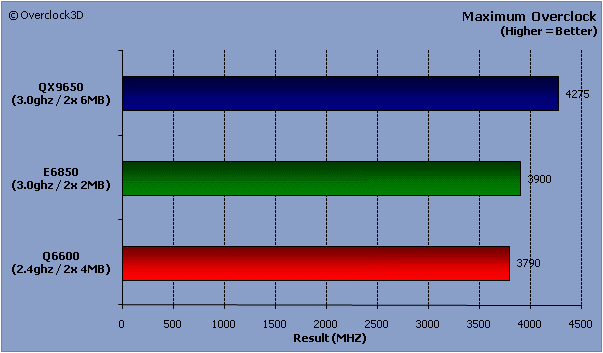Intel Core 2 Extreme QX9650 Quad Core CPU
Test Setup
Â
To ensure that all reviews on Overclock3D are fair, consistent and unbiased, a standard set of hardware and software is used whenever possible during the comparative testing of two or more products. The configuration used in this review can be seen below:
Â
Processor(s)
• Intel Core 2 Extreme QX9650 3.0GHz 2x 6MB
• Intel Core 2 Extreme QX9650 3.0GHz 2x 6MB
• Intel Core 2 Duo E6850 3.0GHz 2x 2MB
• Intel Core 2 Quad Q6600 “G0” 2.4GHz 2x 4MB
Â
Motherboard
• Asus Rampage Formula X48 DDR2
Â
Cooling
• OCZ Vendetta 2 + Stock Fan
Memory
• 2x 1gb Cellshock PC2-6400 @ DDR2-800 (4-4-4-12)
• 2x 1gb Cellshock PC2-6400 @ DDR2-800 (4-4-4-12)
Graphics Card
• Sapphire Ultimate X1950 Pro 256mb PCI-E
Hard Disk
• Hitachi Deskstar 80GB 7K80 SATA2 7200RPM 8mb
Operating System
• Microsoft Windows Vista Ultimate (Latest Updates)
Â
All testing was performed on a fresh install of Windows Vista Ultimate SP1 (32 bit) with latest updates. Both the chipset drivers and other motherboard related drivers were installed from the CD provided with the Rampage Formula motherboard. Drivers for the X1950Pro GPU were obtained directly from ATI’s website and carried version number 8.3.57946 on the install package.
Â
Under normal circumstances we would re-install the OS between changes of hardware to avoid any left-over drivers from previous hardware configurations. However, as the changing of processors has minimal effect on the operating system and no installation or removal of drivers is required, the same installation of Vista was used throughout the testing of the three CPU’s.
Â
The following benchmark utilities have been chosen to show both the synthetic and real-world performance differences in applications and games that either make full or partial use of Symmetric Multiprocessing:
Â
Synthetic CPU & Memory
• Sisoft Sandra XII 2008c
• PCMark Vantage
File Compression & Encoding
• 7-Zip File Compression
• River Past ViMark
• Sisoft Sandra XII 2008c
• PCMark Vantage
File Compression & Encoding
• 7-Zip File Compression
• River Past ViMark
3D / Rendering Benchmarks
• Cinebench 10
• 3DMark05
• 3DMark06
3D Games
• Quake 4
• Bioshock
• F.E.A.R
Â
Â
Overclocking
Â
Intel chips just seem to get better and better at overclocking, and the Yorkfield core certainly isn’t any different. Using only air cooling, the maximum overclock we could obtain from the chip was 4.27ghz – a massive increase of almost 50% for an already highly clocked CPU. As we can see from the graph below, the E6850 and Q6600 65nm process chips couldn’t even come close.
Â
Â
Being able to use upward 0.5x multipliers on the chip certainly gave an extra level of flexibility during our overclocking session, and alleviated a potential trade-off between CPU and Memory speed we would have normally hit using FSB clocking alone. In the end, the settings we settled for were 450FSB x9 with a 1.4500v vcore.



